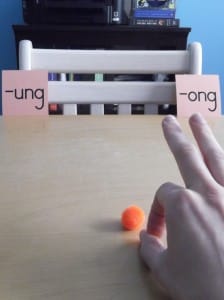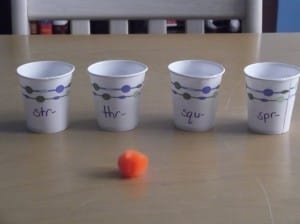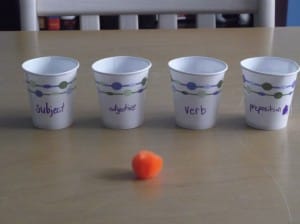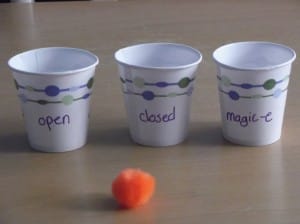Multisensory Monday- Ideas for a Pom-Pom Ball
Posted by Brainspring on 24th Aug 2014
Hi everyone,
Welcome to Multisensory Monday! I don’t know if you’re like me or if your students are like mine, but sometimes my students and I have days where our energy is low and we need something fun and different to liven up our Phonics First lesson. My favorite time to add in something new and exciting is during the Vowel or Skill Intensive.
Last week, one of my students was having a low energy day and I knew I need to come up with something to pep her up and keep her engaged in the lesson. When it was time for the Vowel Intensive, I grabbed a pom-pom ball from the jar in my closet and came up with this game…
Flick It
Like a standard Vowel Intensive, I picked two vowel sounds my student was having difficulty with (“ung” and “ong” in this case). Instead of holding up a vowel stick or making a gesture for the sound she heard in words, she flicked the pom-pom ball at the correct card I was holding up at the edge of the table. 
Keep a look out for a refresher on Vowel Intensives coming soon!
So simple, but so much fun. Students aren’t usually asked to flick objects in school or during tutoring (in fact, they usually get in trouble for doing it), so this is a great treat for them! It also helps them focus on hand-eye coordination and motor skills. My student loved this intensive and even asked to play it at the end of our lesson today.
What other ideas do you have for keeping the Vowel Intensive fresh?
Idea for Three-Letter Blends
After seeing how excited my student was about this simple game, I brainstormed several other multisensory ideas along the same lines. Since it’s difficult to be very accurate when flicking a pom-pom ball my other multisensory ideas involve students tossing the pom-pom ball in a small cup.
For example, for Phonics First Foundations Lesson 2-10 D Three-Letter Blends, set up cups with each of the blends labeled on them. The student has to toss the pom-pom ball into the cup with the blend that matches a word you say.
Or try this version with partners: have the first student draw a slip of paper with a blend word on it. They read the word and then see if they can toss the ball into the proper cup. If they make it in the cup, they get a point. If they don’t make it, they have to try again on their next turn. Either way, it’s the next player’s turn. Players can only draw a new card once they have tossed the ball into the proper cup. They player with the most points at the end wins.
Ideas for Other Skills
This game will work for many lessons, not just Three-Letter Blends. Try any of the blends lessons, ng or nk endings, the Wild Old Words or C-le endings!
Also try this activity for other skills, such as parts of a speech or syllable types.
Comment here with any questions you have or ideas for what you would like to see in an upcoming post.
Blending Book
Students can practice blending if they make their own blending books like Dite shows us this week. What a great idea for a classroom center activity!
Check out her post at http://atlantareads.org/2014/08/multisensory-monday-blending-book/ for instructions.
Younger students can make a basic CVC blending book, while more advanced students could include blends and other skills. More sounds could be added as they are taught. A book like this could help students keep track of what they are learning, as well as giving them a way to practice.



